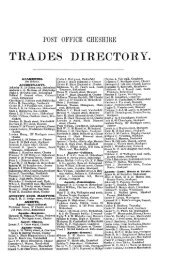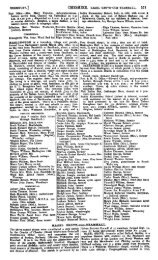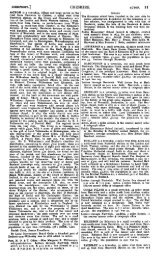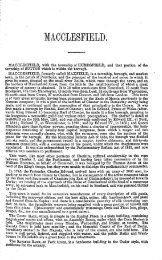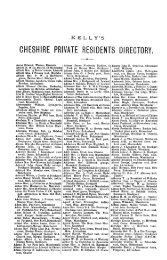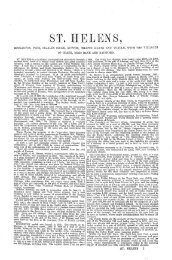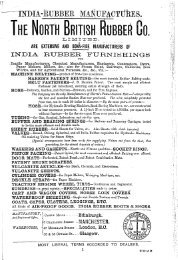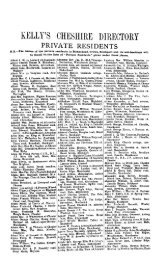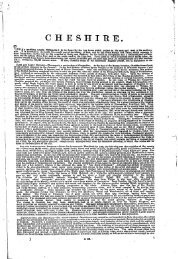DIRECTORY.] CHESHIRE. CHESTER. 213C H E STE i.^CHESTER is a city and county of itself, and the capitalof the county of that name, a municipal, parUamentaryand county borough, sea port, head of a union, countycourt districS and petty sessional (Uvision, in the Eddisburydivision of the county, and is pleasantly seated on, the north bank of the river Dee, a bend of which encirclesnearly one half of the city; it is distant from Bangor59J miles, Birmingham 74, Birkenhead 15, Bolton 36^,Cheadle 37, Crewe zii, Conway a,i\, FUnt 12J, Frodsham9, Glossop 65, Holyhead 84J, Holywell i6|, Hull150, Liverpool 17, London lygj, Manchester 40, MoldJ3J, Nantwich 17!, Oswestry 26J, Oxford 150, Ruabon 17,Sandbach 26i, Shrewsbury 38f, Shifnal 59J, Stafford46J, Stockport 39i, Stoke 364, Sheffield 80, Warrington18, Wrexham 12, 'Wellington 4^ and Wolverhampton 61J.The city stands at the extremi^ of Broxton hundred andat the east end of the peninsula of Wirral, and adjoiningFlintdiire, and is in the rural deanery, archdeaconry anddiocese of Chester. Few places in the kingdom presentto the antiquary attractions of more varied characterthan this ancient city: it is rich in memorable incidentsand assodations, and has a history chronicled not onlyin books, but in its walls, ecclesiastical and other buildings,its unique " rows " and other venerable remains.Chester may not improbably have been a very earlyIberian or British town, and it most certainly was an importantBoman station: the general plan of the cityand the arrangement of the prindpal streets—answeringin some measure to a Roman camp—bear witness to itsRoman origin: to the Roman geographers it was knownas " Deva," or the station on the Dee, where, according tothe Antonine Itinerary, was the station from A.D- 61 ofthe 20th Legion (Valeria Victrix), and this seems to beconfirmed by the name " Caer Leon Gawr,"' or the " cityof the great legion," assigned to it by the British; thisview is further strengthened by the discovery here ofvotive altars and sculptured tonibstones, the inscriptionson which show that they were erected by officers andother's belonging to Roman legions, besides which manyand various other Roman remains have been met with atdifferent periods. The 20th Legion quitted Deva aboutA.D. 406; and it then reverted to the Britons, f 1 om whomit was taken in 607 by Ethelfrith the Fierce, King ofNorthumbria; the Britons, however, regained possession,and continued to hold the place till they were dispossessedin 828-30 by Egbert, who, as sole monarch, added Legancester,as it was caUed by the Saxons, to his otherdominions; in 894 it was taken and ravaged by the Danes,and on their retreat, the city walls were rebuilt, aboutgo8, by Ethelfleda, Countess of Mercia; but after herdeath, the Britons once more became its masters, onlyto be again expeUed by Edward the Elder : in the summerof 973, Edgar received on the Dee the homage of variousinferior Saxon sovereigns, and according to some writers,was rowed from his palace on the south bank of rhe riverto the conventual church of St. John by eight tributarykings: on the division of the country in 1016 betweenEdmund Ironside and Canute, Chester, as part of Mercia,was retained by the latter. Under the Normans Chesterincreased considerably in importance, and after the Conquest,the Earldom of Chester (county) was conferred onGeorbodus, a nobleman of Flanders, who, however, nevertook possession of his territory, and, returning to theContinent, died soon after, upon which the dignity wasbestowed by the Conqueror, in 1070, upon his haUsister'sson, Hugh de Abrincis (or Avranches), surnamed"Lupus," who had his residence and held his courts andparliaments here, to which he summoned the barons andlandowners of the shire; this powerful and wealthy nobleeventually died as a monk in the abbey of St. Werburgh,at Chester, 27 July, iioiiand on the death in Dec, iiigof his son Richard, 2nd earl, the male Une then becomingextinct, the earldom passed to his ist cousin, Ranulphde Meschines, son of Balph de Meschines, who hadmarried Maud de Abiincis, sister of Earl Hugh Lupus:Ritoulph or Ralph de Mesdiines, 4th Earl of Chester of this ,family, and sumamed "BlundevU," died at WaUingford, '26 Oct. 1232, and the earldom then devolved upon his jnephew, John le Scot, as "Earl Palatine," at whosedecease, by poison, in 1244, the male Une again failed, |and in 1246, the Earldom of Chester was for ever annexed |to the Cirown by Henry IH. and the title has since that jtime "excepting the short period 1264-5, when possession ,thereof was obtained by the rebellious Simon de Montfort," jbeen bome only by the heir apparent of the sovereign:by the Act 21 Rich, II. c, 9 (1398) the earldom of Chesterwag erected into a PrincipaUty, and although this Actwas annulled by the Act i Hen. IV. c. 3, the earldomof Chester has ever since been granted in conjunction |with the Principality of Wales, and H.M. King GeorgeV. thus received both titles gth Nov. 1901. The cjtysuffered severely during the sanguinary period of theWars of the Roses, and was on one occasion (in 1455)visited by Margaret of Anjou, the warlike queen ofHenry VI. King James I. on his journey into Scotlandin 1617 passed through Chester, and received from themayor the city sword, which, being re-delivered to him,was borne by the mayor on horseback before the king. Onthe breaking out of the Civil War, the city was in 1642the head quarters of the RoyaUsts in this locality ; and in1645, under the governorship of John, ist Lord Byron, anda distinguished cavalier, withstood, under great privations,the attacks of Sir William Brereton; tbe king thereuponcame to its relief (22 Sep. 1645), ^°* *^® royal forcesbeing defeated on Rowton Heath, 2 miles from the city,on the 24th, the king, after remaining one night, retiredto Denbigh, and the place was eventuaUy surrendered 3Feb. 1646. In Aug. 1659, Sir George Booth and SirThomas Middleton surprised and took it, but were defeatednear Nantwich by General Lambert, who then advancedupon and recaptured Chester; tihe city was visitedby James II. in 1687, and on the rebellion of 1688, wasseized by Lords Molyneux and Aston in the royal interest,but the speedy abdication of James rendered their effortsuseless: under WiUiam III. Chester was appointed oneof six places for the assay of gold and silver, and thisprivilege is still retained; in the Jacobite rising in 174=:,it was fortified and garrisoned against the Pretender, thisbeing the last important military event in its history,but it is still a ohief miUtary centre. On the n and 12Feb. 1867, the castle was threatened by attack by theFenians, whose intentions, however, were rendered futileby the activity of the authorities. The Exchange andTown Hall, burnt down 30 Dec. 1862, were reopened byHis late Majesty King Edward VII. then Earl ofChester, 15 Oct. 1869.Chester is entirely surrounded by waUs, which areamong the most perfect examples of such fortificationsto be found in the kingdom: they are built ot soft freestoneand are nearly two mUes in circumference, varyingfrom about 12 to 40 feet in height, with a paved walkon the top, of sufficient width in the narrowest part toadmit of two persons walking abreast, thus affording abeautiful promenade, in the circuit of which a varietyof pleasing prospects are presented to the eye, includingthe Roodee, or race-course, the river Dee and Peckfortonand Beeston Castles and the mountains of Flintshireand Denbighshire: the waUs are said to havebeen rebuUt and their circuit enlarged by Ethelredand Ethelfieda, Earl and Countess of Mercia, aboutthe year 908, and they still have, besides posterns,.four principal gates, viz. East gate, North gate. Bridgegate and Water gate. East gate consists of a singlelofty arch for the passage of carriages, and two posternsfor foot passengers : it was built in 1769, on thesite of the ancient gate, at the expense of Richard,ist Baron Grosvenor, whose arms, with those of thecity, occupy the centre of the archway. North gate,a similar structure, formerly served as the city prison,and was in the charge and keeping of the sheriffs.Bridge gate, which has also a central arch and twoposterns, was erected in 1782, at the expense ot theCorporation and had formerly an octagonal tower,V\^ater gate, built of local red sandstone, painted toimitate freestone, was built in 1788, on the site of theancient Water gate, the expenses being defrayed out ofthe Murage duties, and it acquired its name from thefact that the tide once flowed up to this spot. Theprincipal postern gates were Kail yard. New gate (formerlycalled Wolf gate) and Ship gate.The walls were formerly defended by various towers;the New Tower, sometimes called the Water Tower,projecting from the waUs towards the Dee and twentyfourfeet in height, was buUt in 13^2, at the expense ofthe citizens; large iron rings were attached to thistower, to which vessels were fastened which came upto this point before the harbour became choked withsand: a thoroughfare tower, leading to the WaterTower, was anciently called Bonewaldesthome Tower.The Phoenix Tower,' from which Charles I. witnessedthe defeat of his army, commanded by Sir MarmadukeLangdale, at Eowton Moor (24 Sept. 1645), by the Parliamentaryforces, under Sir WiUiam Brereton and Col,Poyntz, takes its name from the crest of the Paintersand Stainers, who, with other companies, held theirmeetings in this tower: it was formerly caUed NewtonTower; there were, besides these. Goblin's Tower, nowknown by the name of Pemberton's Parlor, of which
214 CHESTER. CHESHIRE. [KELLY'Sonly a portion remains, and the Saddler's Tower, whichstood near the Cathedral, but was taken down in 1780,The city consists principally of four streets, excavatedout of the soUd rock and diverging at right angles tothe cardinal points from a centre, where formerly stooda stone cross, called the High Cross, pulled down in1646, after the city had fallen into the hands of theParliamentary army, but a portion of tbe structure isstill preserved in the Grosvenor Museum ; the first floorsof the houses on both sides at an average height ofabout 10 feet above the level of the carriage-way, arecontinuously open to the street, and form the famous" Rows," which are a species of elevated corridors orambulatories with shops at the back, affording a shelteredpromenade for foot passengers over the shopsbelow and communicating with the streets by flightsof steps placed at intervals: in the "Rows'" and elsewherewithin the city walh there are stUl extant manyhighly interesting examples of the timber-framed andplaster houses peculiar to this county, and some ofthese are richly ornamented with carved work andpargeting: " God's Providence House," in Watergate«t-eet, dated 1652, and reconstructed in 1862, taktes itsname from the motto, " God's providence is mine inheritance,"carved on one of the exterior beams, and said to havebeen thus inscribed by a former tenant who escaped theplague, which had visited almost every other house inthe city: the house of Bishop Lloyd (1615) and that ofthe Stanley family (1591) are also in this street: anotherfine example is the Bear and Billet inn, in Bridge street,which thoroughfare also affords several other quaintspecimens of this style: the streets are paved with stoneand lighted with gas from works in Paradise row, near theRoodee, originally erected in 1818 in Cuppin street, bythe Chester Gas Light Company, amalgamated in 1856with the Eoodee Gas Company, under the name of TheChester United Gas Company and also by electric lightsupplied by the corporation from their new works inMiddle Crane street. The water supply is derived fromworks at Barrell WeU and Spitalfield walk, the propertyof the Chester Water Works Company, whose offices arein Newgate street.Chester is amply provided with railway communicationand has three stations. The general station at thetop of City road, into which the trains of the GreatWestern and London and North Western companiesrun, is the joint property of these two companies; there-are 8 platforms, the two longest being 520 yards eachin length; two others, known as the Island platformsand erected in 1890, are each 340 yards long; in 1890various improvements were carried out. including theextension ot the glazed iron roof, so as to cover thewhole of the platforms.The station of the <strong>Cheshire</strong> Lines Committee, in Victoriaroad, called " Northgate station," was opened fortraffic in 1875, and has two platforms each 100 yardslong; the whole is covered by a light iron framed andglazed roof.The Great Central Eailway (late Manchester, Sheffieldand Lincolnshire) station in Liverpool road was openedin 1890 and a branch line has since been made from thisstation to Hawarden, affording communication with Wrexham,and a line has been constructed so as to connectGbe.ster -with the Cambrian railways and South Wales withBiTkenhend, Hoylake and Seacombe.The city is a seaport and under the Act of 1846 itslimits were declared to be from the eastern end of thebridge to Red Stones, at Hoylake, to the Voryd or Clwydriver, and along the seashore and western side of the Dee,to the westem end of the bridge, including the riversDee and Voryd : fishing boats and their implements tobe distinguished by the letters CH.; the river Dee hasbeen canalized from the city to Connah's quay at itsestuary, which expands to a considerable width.The Old Bridge over the Dee, at the Bridge gate, consistingof seven irregular arches, is of considerable antiquity,but has been rebuUt and repaired at differenttimes: the ancient gates, which formerly stood one ateach end, were taken down, one in 1782 and the otherin 1784.Grosvenor Bridge, which crosses the Dee near theracecourse, was erected at a cost of ;^36,ooo, from designsby Mr. Thomas Harrison, architect, and is astructure of freestone, consisting of one arch, with aspan of 200 feet; the- height from the springing line is40 feet, the length of the roadway 340 feet and width35^ feet: it was formally opened by Her late MajestyQueen Victoria (then Princess Victoria), upon theoccasion of her visiting Eaton Hall in 1832.The Suspension Bridge crossing the Dee, a light andhandsome structure, leads to the suburb called "Queen'sPark,"At the time of the Conquest Chester ranked as aMerchant Guild, and the chief citizens assembled inguild to make laws for their guidance and protection;charters of privUeges were granted to the city by thesuccessive Norman earls, and these were confirmed andenlarged by Hen, II. and John, and Hen. III. in 1242constituted the chief magistrate mayor: Henry VII. bycharter, in 1506, made the city of Chester a county in 'itself, and granted to the mayor and corporation jurisdictionover the river Dee, from Heron Bridge toArnold's Eye: during the Commonwealth the city,wasdeprived of its privileges as a separate county, and theCorporation dissolved 17 Sept. 1659; but in 1664,Charles II. confirmed the grant and charter of HenryVII. and the Corporation continued to be elected underthe charter of Charles II. untU the passing of the" Municipal Corporations Act. 1835'' (5 and 6 Wm.IV. c 76), by which the city was divided into fivewards, each returning 6 councillors; and the Corporationnow consists, under this Act, and the later Actof 1882 (45 and 46 Vict, c 50), of a mayor, sheriff,ten aldermen and thirty councillors, who also, act asthe Urban Sanitary Authority; by the Local GovernmentBoard's Chester Order 1898 certain alterationsof boundaries were made in connection with ChesterCastle parish and the township of Blacon. The cityhas a commission of the Peace and separate court ofQuarter Sessions and a police force, and ancient Courtsof Record caUed the " Court of Pentice " and the "Courtof Portmote." Under the "Local Government Act, 1888,"Chester is declared a " county borough," for certain purposesof that Act.Chester returned two members to Parliament fromthe ist year of Queen Mary (1553), the elective franchisebeing vested in the freemen and householders; butunder the " Redistribution of Seats Act, 1885,'' therepresentation was reduced to one member, the franchisehaving been previously extended in accordance with the"Representation of the People Act, 1867" (30 and 31Vict. c. 102).The city arms:—"England, dimidiating az. 3 garbs,or," are probably at least as old as 1283, and were confirmedby WUliam Flower, Norroy, 3 Sept. 1580, with crestand supporters ; but in the 17th and i8th century, the coat—" az. 3 garbs, or," surmounted by a sword in palewasused.The see of Chester, originated in 1075, when Peter,34th bishop of Lichfield, removed the seat of his dioceseto this city, with the church of St, John the Baptistas a cathedral, thus occasioning his successors to befrequently styled bishops of Chester, although the nextbishop, Eobert de Lindsey, prebend of St. Paul's, translatedthe head of the see to Coventry, where it remainedtiU about 1086, when Hugh Novant, prior ofthe Carthusians, re-established it at Lichfield. Chester,however, was not created a distinct and separate seeuntil 1541, when it was chosen as one of the six newbishoprics made by Henry VIII. and the church of theBenedictine abbey of St. Werburg, founded in 1053 byHugh Lupus, Earl of Chester, was assigned as thecathedral church and re-dedicated to Christ and theBlessed Virgin. The diocese now consists of the entirecounty of Chester, except parts of the parishes ofThreapwood and Whitchurch, and part of Mottram inLongdendale, and it also includes portions of theparishes of Doddleston, Hawarden, and Malpas, in Flintshire,of Ashton-under-Lyne, in Lancashire, and ofBarthomley, in Staffordshire. There are two archdeaconries(Chester and Macclesfield), 12 rural deaneries,and 265 benefices. The revenue of the see, which in1824 was only ^^1,700 a year, was increased by theEcclesiastical Commissioners to ;^4,20o.Among the Bishops of Chester may be mentioned JohnBird, appointed to the see on its creation in 1541; I16had been a monk of the Carmelite order, and sometimeabbot of Chester, suffragan bishop of Penrith, in i537'and bishop of Bangor in 1539; in 1553-4 he was deprivedby Mary for having married, but afterwardsconforming, was employed as suffragan to BishopBonner of London; he died in 1558. George Coates,his successor (1554-6), was master of Balliol College,Oxford, 1539-45; Thomas Morton (1616-19), and afterwardsof Durham, was the author of the " Book ofSports; " Brian Walton (1660-1), was the editor ofthe " Hexapla Polyglot Bible," and died 29 Nov. 1661;John Wilkins (1668-72), an astronomer and one of thefounders of the Royal Society; John Pearson (1673-80),author of " An Exposition of the Creed; " Sir WUliamDawes, bart. (1708-14), archbishop of York (i7i4"24)'and died 30 April, 1724; BeUby Porteus (1776-87), and
- Page 1: 184 BIKTLES.Rogers Thos. corn mille
- Page 4: DIRECTORY.] CHESHIRE. BOSLEY. 187La
- Page 7 and 8: 190 BOWDON. CHESHIRE. [KELlVfePubli
- Page 9 and 10: 192 BOWDON.Atkinson Cyril, barriste
- Page 11 and 12: 194 BREDBURY.HelleweU Edwin, Horsfi
- Page 13 and 14: 1V6 BROMBOROUGH. CHESHIRE. [KHLLT'S
- Page 15 and 16: 198 GREAT BUDWOKTH.Worrall Mary (Mr
- Page 17 and 18: 2J0 BUGLAWTON. CHESHIRE. [KELLY'PRI
- Page 19 and 20: 202 BUNBURY.CHESHIRE. [KELLY'S1849
- Page 21 and 22: 204 BURTON, CHESHIRE. [KELLY'SJones
- Page 23 and 24: 206 GARRINGTON. CHESHIRE. [KELLY'Sp
- Page 25 and 26: 208 CHEADLE.CHEADLE.PRIVATE RESIDEN
- Page 27 and 28: 210 CHEADLE.Crane Edwin Robert, 8 H
- Page 29: 212 CHEADLE. CHESHIRE.CHELFOBD is a
- Page 33 and 34: 216 CHESTER. CHESHIRE. [KELLY'SJohn
- Page 35 and 36: 218 CHESTER.CHESHIRE.sittings. The
- Page 37 and 38: 220 CHESTER. CHESHIRE. [KELLY'Srefe
- Page 39 and 40: 222 CHESTER. CHESHIRE [KELLY*8CuUim
- Page 41 and 42: ik 224 CHESTER. CHESHIRE. [KELLY'S6
- Page 43 and 44: 226 CHESTER. CHESHIRE. [KELLY'SSt.
- Page 45 and 46: 228 CHESTER, CHESHIRE. [KELLY'SAbbe
- Page 47 and 48: 230 CHESTER.Brook lane, Liverpool r
- Page 49 and 50: 232 CHESTER.CITY ROAD—continued.8
- Page 51 and 52: 234 CHESTER.EGERTON ST9EET—contin
- Page 53 and 54: 236 CHESTER.GLADSTONE ROAD—con.23
- Page 55 and 56: 238 CHESTER.LORD STREET—continued
- Page 57 and 58: 240 CHESTER.NORTHGATE STREET—con2
- Page 59 and 60: 24*3 CHESTER.St. John street, Foreg
- Page 61 and 62: 244 CHESTER.Trinity street, Waterga
- Page 63 and 64: 24-) CHESTER. CHESHIRE. [KELLY'SCHE
- Page 65 and 66: 248 CHESTER. CHESHIRE. [KELLY'SGree
- Page 67 and 68: 250 CHE&TER.Roberts John Sheriff, T
- Page 69 and 70: 252 CHESTER. CHESHIRE. [KELLY'SBank
- Page 71 and 72: 254 CHESTER. CHESHIRE. [KELLY'SChes
- Page 73 and 74: 256 CHESTER.Davies WiUiam T. 4 Sons
- Page 75 and 76: 256 CHESTER. CHESHIRE. [KELLY'SGarn
- Page 77 and 78: 260 CHESTER. CHESHIRE. [KELLY'SHump
- Page 79 and 80: 262 CflESTER. CHESHIRE. [KELLY'SLon
- Page 81 and 82:
264 CHESTER. CHESHIRE. [KELLY'SPate
- Page 83 and 84:
2i)6 CHESTER. CHESHIRE. [KELLY'SSel
- Page 85 and 86:
268 CHESTER. CHESHIRE. [KELLY'SWalk
- Page 87 and 88:
270 CHRISTLETON. LlIESHIRE. [KELLYI
- Page 89 and 90:
272 CHURTON HEATH. CHESHIRE. [KELLY
- Page 91 and 92:
274 COMPSTALL.•Falkner John, farm
- Page 93 and 94:
276 CONGLETON. CHESHIRE. [KELLY'SSo
- Page 95 and 96:
278 CONGLETON. CHESHIRE. [KELLY'SPB
- Page 97 and 98:
280 CONGLETON. CHESHIRE. [KELLY'SDa
- Page 99 and 100:
282 CONGLETON. CHESHIRE. [KELLY'3Ro
- Page 101 and 102:
284 CREWE.The meetings of the Town
- Page 103 and 104:
286 CREWE. CHESHIRE. [K?I,^,lfffSan
- Page 105 and 106:
288 CREWE. CHESHIRE. [KELLY'Sinfant
- Page 107 and 108:
290 CREWE. CHESHIRE. [KELDSL'SAthle
- Page 109 and 110:
292 CREWE. CHESHIRE. [KELLY*8Orewe
- Page 111 and 112:
294 CREWE. CHESHIRE. 8Henson Oliver
- Page 113 and 114:
296 CREWE. CHESHIRE. [KELLY*SMerry
- Page 115 and 116:
298 CREWE. CHESHIRE. [KELLY'STaylor
- Page 117 and 118:
300 CROWTON.Gallagher Rev. James M.
- Page 119 and 120:
302 DARESBURY.! CHBSHIRE.NEWTON-BY-
- Page 121 and 122:
304 DAVENHAM.fFrance-Hayhurst Fredk
- Page 123 and 124:
3Jt)DELAMERE.fStockton Mark, farmer
- Page 125 and 126:
308 DODCOTT-CUM-WILKSLKY. CHESHIRE.
- Page 127 and 128:
310 DUKINFIELD. CHESHIRE. [KELLY'SP
- Page 129 and 130:
3 I 2 DUKINFIELD. CHESHIRE. [SELLfW
- Page 131 and 132:
314 DUKINFIELD. CHESHIRE. JiKEhLfmD
- Page 133 and 134:
316 DUKINFIELD. CHESHIRE. [KELLY'SR
- Page 135 and 136:
318 DUNHAM MASSEY.Carter George E.
- Page 137 and 138:
320 EASTHAM. CHESHIRE. [KELLY'Sland
- Page 139 and 140:
322 ECCLESTON.McGrigor Col. Charles
- Page 141 and 142:
324 EGREMONT. CHESHIRE. [KELLY'8Jam
- Page 143 and 144:
326 EGREMONT. CHESHIRE. [KELbffJlFu
- Page 145 and 146:
328 ELLESMEl.E PORT. CHESHIRE. [KEL
- Page 147 and 148:
330 ELLESMERE PORT.Jones Charles Wi
- Page 149 and 150:
332 FARNDON. CHESHIRE. [KELLY'Sendo
- Page 151 and 152:
334 FRODSHAM. CHESHIRE. [KELLY'Efee
- Page 153 and 154:
336 FRODSHAM.Heywood 4 Massie Limit
- Page 155 and 156:
338 GATLEY.Lockhart Eobert Jardine,
- Page 157 and 158:
340 GOOSTREY-CUM-BARNSHAW. CHESHIRE
- Page 159 and 160:
342 HALE. CHESHIRE.Medicd Officer o
- Page 161 and 162:
344 HALE.Morton Benjamin, Edgworth,
- Page 163 and 164:
316 HALE. CHESHIRE. [KEILil/T'^Maso
- Page 165 and 166:
348 HANDFORTH. CHESHIRE. [KELLY'Sdo
- Page 167 and 168:
3 50 HARGRAVE.FarraU James, cowkeep



